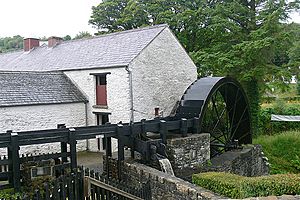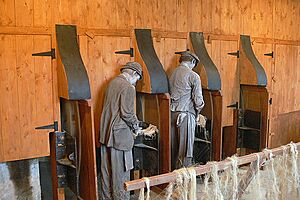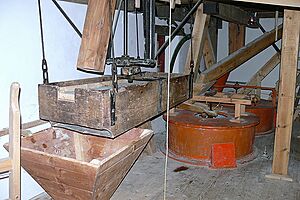Newmills Corn and Flax Mills facts for kids
Newmills Corn and Flax Mills (Irish: An Muileann Úr – Muilte Arbhair agus Lín) is a historic grain mill located in County Donegal, Ireland. You can find it on the R250 near Churchill, right by Newmills Bridge on the south side of the River Swilly. It's about 5 kilometres west of Letterkenny in a small area called Milltown. This special place has one of the largest working waterwheels in the whole country! A long channel, called a millrace, is 1 kilometre long. It brings water to power two separate mill wheels. One wheel grinds grains like oats and barley, and the other processes flax.
History of the Mills
Corn and flax mills have been operating at this spot since the early 1800s. Joseph Hunter first owned them. Having both corn and flax mills together was common in Ulster, as both were very important for the local farms.
In 1861, Joseph Hunter sold the mills to John Devine. Later, in 1892, Patrick Gallagher bought the whole complex from William Devine, John's son. Besides the mills, Patrick Gallagher also bought a house, a pub, a grocery store, and other buildings. These included a small house for a "scutcher," who was a person who prepared flax. There was also a blacksmith's shop across the road and a large farm. Patrick's son, P.F. Gallagher, continued the family business until he passed away in 1980.
When Patrick Gallagher bought the mills in 1892, they were in poor condition. The corn mills were not even being used and had become farm buildings. Patrick Gallagher made big improvements to the corn mill around 1907. He installed the large waterwheel you see today and updated the machines inside the mill.
During the Second World War, P.F. Gallagher helped with the war effort. The British Government offered money to increase flax production to make sure there was enough linen for the war. In the early 1940s, he built a more modern flax mill. The pub and grocery store were also a very important and successful part of the business in the early 1900s. They even had a lively export trade. When Sir Thomas Lipton started his grocery business in Glasgow, his first delivery of butter, bacon, and eggs came from Newmills!
In 1978, experts recognized how important Newmills was. They said it was the best example of a mill complex in County Donegal. To protect it, the Irish government bought the mills in 1986 to preserve them as a national monument. In 1989, with help from the Office of Public Works, volunteers from Ireland and other countries worked together to restore the mills and the millrace.
The Corn Mill
The corn mill mainly processed oats and barley grown by local farmers. It also ground imported maize. The mill building has three floors. All the machines inside, like the grinding stones, sieves, and lifts for sacks, were powered by a huge 7.63-metre (25-foot) waterwheel. This waterwheel was made in 1867. It turned slowly, about three times a minute, creating enough power to run the mill. This power was sent to the machines using gears and belts. The building also had a special oven, called a kiln, for drying the grain.
Harry Pinkerton, who was the miller at Newmills for some years after the Second World War, said the mill worked almost all year. From the harvest in late summer until April or May the next year, the mill was busy grinding local grains. In the summer, they would prepare animal feed, usually by mixing maize with oats.
The first step for the grain was to dry it. Farmers would bring their grain to the mill. The grain was spread about 15 centimetres (6 inches) deep on a drying floor. This floor was made of metal plates with holes. Heat from the kiln below warmed these plates. The kiln was fired with a special smokeless coal, not turf, because turf would give the oats a bad taste. The kiln could dry two tonnes of oats a day, and even more if they dried some overnight.
Next, the grain went to the shelling stones. These stones separated the outer shell, or husk, from the inside part of the grain. After that, the kernels were ground into oatmeal by the grinding stones. These grinding stones were usually made from a type of stone called French burr. The grinding surfaces had to be sharpened regularly by a process called "dressing" or "picking." The top stone could be moved up or down. This allowed the miller to make different types of oatmeal, like fine, pinhead, or coarse.
The ground meal was then lifted to the first floor. There, it was cleaned and sieved using shakers and fans. After cleaning, it was brought back to the lower ground floor to be put into bags. Then, the bags were lifted to a storage area to wait for farmers to pick them up. The whole milling process was very clever, using lifts, belts, and pulleys. One person could manage most of the work. It took about 75 kilograms of oats to make 50 kilograms of meal. The miller would weigh the ground meal. As payment, the miller would keep about 4.5 kilograms of meal from every 50-kilogram bag.
The original family home, shop, and pub are still on the grounds. They are also owned by the government and are being repaired.




